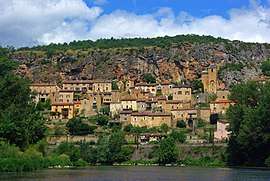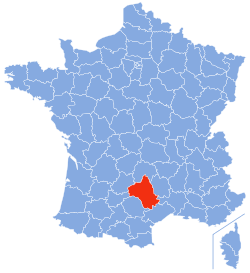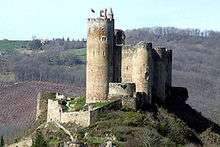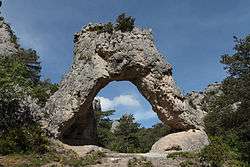Aveyron
Aveyron (French: [avɛʁɔ̃] (![]()
Aveyron | |
|---|---|
 .jpg)    From top down, left to right: Conques, prefecture building in Rodez, Castle of Belcastel, Aveyron River in Villefranche-de-Rouergue and Peyre | |
 Flag  Coat of arms | |
 Location of Aveyron in France | |
| Coordinates: 44°15′N 02°42′E | |
| Country | France |
| Region | Occitanie |
| Prefecture | Rodez |
| Subprefectures | Millau Villefranche-de-Rouergue |
| Government | |
| • President of the Departmental Council | Jean-François Galliard (UDI) |
| Area | |
| • Total | 8,735 km2 (3,373 sq mi) |
| Population (2016) | |
| • Total | 278,697 |
| • Rank | 78th |
| • Density | 32/km2 (83/sq mi) |
| Time zone | UTC+1 (CET) |
| • Summer (DST) | UTC+2 (CEST) |
| Department number | 12 |
| Arrondissements | 3 |
| Cantons | 23 |
| Communes | 285 |
| ^1 French Land Register data, which exclude estuaries, and lakes, ponds, and glaciers larger than 1 km2 | |
History

Aveyron is one of the original 83 departments created during the French Revolution on 4 March 1790. The first known historical inhabitants of the region were the Rutenii tribe, but the area was inhabited previously to this, boasting many prehistoric ruins including over 1,000 dolmens, more than any other department in France.

During the medieval and early modern periods, and until the 1790s, the territory covered by Aveyron was a province known as Rouergue. In 1797, Victor of Aveyron (the Feral child of Aveyron) was found wandering the woods in the area. The story of Victor is told in the film The Wild Child.
In 1817, a local prosecutor, Antoine Bernardin Fualdès, was assassinated. The sordid circumstances of his death, following which his body was found floating in the Aveyron River, led to the matter becoming publicised as a cause célèbre. Recent studies have indicated that he met his end at the initiative of a right-wing royalist organisation known as the Chevaliers de la Foi (Knights of Faith).
Heraldry
 Arms of Aveyron |
The Arms of Aveyron are those of the province of Rouergue and are blazoned as follows:
Blazon: |
Geography
Aveyron is the centre of a triangle formed by the cities of Toulouse, Clermont-Ferrand, and Montpellier. The department approximately follows the outline of the former province of Rouergue. It is the 5th largest department in metropolitan France in terms of area (8,735 km2 (3,373 sq mi)). Its prefecture is Rodez.
The department comes under the jurisdiction of the Academy of Toulouse and the Montpellier Court of Appeal. The INSEE and Post Code is 12. Aveyron is located in the south of the Massif Central. The highest point in the department is the summit of Le Signal de Mailhebiau at 1469m on the Plateau of Aubrac. The Aveyron department is divided into several natural regions such as the Grand Causses and Rougiers.
Aveyron department consists of an ancient high rocky plateau of great geological diversity. The Truyère, Lot, Aveyron, and Tarn rivers have carved a lot of deep gorges. The department is surrounded by the departments of Tarn, Tarn-et-Garonne, Lot, Hérault, Gard, Lozère and Cantal. The Lac de Villefranche-de-Panat is used as a reservoir to provide drinking water supplies for the region.
Climate
| Town | Sunshine (hours/yr) |
Rain (mm/yr) | Snow (days/yr) | Storm (days/yr) | Fog (days/yr) |
|---|---|---|---|---|---|
| National Average | 1,973 | 770 | 14 | 22 | 40 |
| Millau[3] | 2,146 | 732 | 25 | 25 | 59 |
| Paris | 1,661 | 637 | 12 | 18 | 10 |
| Nice | 2,724 | 767 | 1 | 29 | 1 |
| Strasbourg | 1,693 | 665 | 29 | 29 | 56 |
| Brest | 1,605 | 1,211 | 7 | 12 | 75 |
| Climate data for Millau | |||||||||||||
|---|---|---|---|---|---|---|---|---|---|---|---|---|---|
| Month | Jan | Feb | Mar | Apr | May | Jun | Jul | Aug | Sep | Oct | Nov | Dec | Year |
| Record high °C (°F) | 17.6 (63.7) |
21.8 (71.2) |
23.9 (75.0) |
27.0 (80.6) |
29.2 (84.6) |
35.1 (95.2) |
37.5 (99.5) |
38.0 (100.4) |
34.1 (93.4) |
28.9 (84.0) |
23.9 (75.0) |
19.1 (66.4) |
38.0 (100.4) |
| Average high °C (°F) | 6.1 (43.0) |
7.3 (45.1) |
10.8 (51.4) |
13.5 (56.3) |
17.7 (63.9) |
21.9 (71.4) |
25.5 (77.9) |
25.1 (77.2) |
20.7 (69.3) |
15.5 (59.9) |
9.7 (49.5) |
6.9 (44.4) |
15.1 (59.2) |
| Daily mean °C (°F) | 3.2 (37.8) |
3.9 (39.0) |
6.7 (44.1) |
9.1 (48.4) |
13.2 (55.8) |
16.9 (62.4) |
19.9 (67.8) |
19.6 (67.3) |
15.9 (60.6) |
11.9 (53.4) |
6.7 (44.1) |
4.0 (39.2) |
10.9 (51.6) |
| Average low °C (°F) | 0.2 (32.4) |
0.4 (32.7) |
2.6 (36.7) |
4.7 (40.5) |
8.6 (47.5) |
11.9 (53.4) |
14.3 (57.7) |
14.1 (57.4) |
11.1 (52.0) |
8.3 (46.9) |
3.6 (38.5) |
1.1 (34.0) |
6.7 (44.1) |
| Record low °C (°F) | −17.5 (0.5) |
−19.4 (−2.9) |
−12.9 (8.8) |
−5.5 (22.1) |
−2.0 (28.4) |
3.0 (37.4) |
6.0 (42.8) |
4.9 (40.8) |
1.6 (34.9) |
−4.1 (24.6) |
−10.3 (13.5) |
−13.0 (8.6) |
−19.4 (−2.9) |
| Average precipitation mm (inches) | 55.4 (2.18) |
47.4 (1.87) |
42.5 (1.67) |
69.9 (2.75) |
73.4 (2.89) |
60.5 (2.38) |
39.7 (1.56) |
54.8 (2.16) |
77.7 (3.06) |
79.6 (3.13) |
69.1 (2.72) |
61.6 (2.43) |
731.6 (28.80) |
| Average precipitation days (≥ 1 mm) | 8.7 | 7.7 | 7.9 | 9.4 | 8.8 | 6.7 | 4.2 | 5.5 | 6.8 | 8.8 | 9.3 | 8.8 | 92.6 |
| Mean monthly sunshine hours | 100 | 115 | 173 | 183 | 218 | 262 | 296 | 261 | 208 | 132 | 100 | 98 | 2,146 |
| Source 1: Meteorological data for Millau – 715m altitude, from 1981 to 2010 January 2015 | |||||||||||||
| Source 2: Record temperatures for Millau since 1951 January 2015 | |||||||||||||
Demography
In 2010, the department had 276,805 inhabitants. The evolution of the number of inhabitants is known through the population censuses conducted in the department since 1793. From the 21st century, a census of municipalities with fewer than 10,000 inhabitants is held every five years, unlike larger towns that have a sample survey every year.[Note 1]
| 1791 | 1801 | 1806 | 1821 | 1831 | 1836 | 1841 | 1846 | 1851 |
|---|---|---|---|---|---|---|---|---|
| 371,835 | 318,340 | 331,921 | 339,422 | 359,056 | 370,951 | 375,083 | 389,121 | 394,183 |
| 1856 | 1861 | 1866 | 1872 | 1876 | 1881 | 1886 | 1891 | 1896 |
|---|---|---|---|---|---|---|---|---|
| 393,890 | 396,025 | 400,070 | 402,474 | 413,826 | 415,075 | 415,826 | 400,467 | 389,464 |
| 1901 | 1906 | 1911 | 1921 | 1926 | 1931 | 1936 | 1946 | 1954 |
|---|---|---|---|---|---|---|---|---|
| 382,074 | 377,299 | 369,448 | 332,940 | 328,886 | 323,782 | 314,682 | 307,717 | 292,727 |
| 1962 | 1968 | 1975 | 1982 | 1990 | 1999 | 2007 | 2010 | - |
|---|---|---|---|---|---|---|---|---|
| 290,489 | 281,568 | 278,306 | 278,654 | 270,141 | 263,924 | 274,425 | 276,805 | - |
Second homes
According to the general census of the population on 1 January 2008, 17.8% of available housing in the department were second homes.
This table shows the main towns of Aveyron including second homes and occasionally exceed 10% of total housing .
| Town | Municipal Population | Number of Residences | Secondary Residences | % Secondary Residences |
|---|---|---|---|---|
| Brusque | 314 | 429 | 249 | 58.04% |
| Nant | 920 | 929 | 532 | 57.24% |
| Saint-Jean-du-Bruel | 693 | 830 | 469 | 56.52% |
| Najac | 752 | 930 | 503 | 54.09% |
| Canet-de-Salars | 410 | 438 | 226 | 51.60% |
| Saint-Chély-d'Aubrac | 549 | 474 | 215 | 45.36% |
| Salles-Curan | 1,064 | 923 | 415 | 44.90% |
| Saint-Laurent-d'Olt | 661 | 545 | 232 | 42.49% |
| Arvieu | 861 | 635 | 269 | 42.36% |
| Broquiès | 644 | 524 | 209 | 39.94% |
| Brommat | 710 | 613 | 231 | 37.68% |
| Saint-Geniez-d'Olt | 2,034 | 1,596 | 580 | 36.37% |
| Villefranche-de-Panat | 778 | 600 | 217 | 36.17% |
| Laguiole | 1,269 | 1,063 | 377 | 35.48% |
| Saint-Rome-de-Tarn | 845 | 605 | 207 | 34.14% |
| Camarès | 975 | 756 | 252 | 33.27% |
| Sainte-Geneviève-sur-Argence | 1,011 | 732 | 214 | 29.26% |
| Entraygues-sur-Truyère | 1,171 | 862 | 224 | 25.96% |
| Cransac | 1,681 | 1,357 | 310 | 22.84% |
| Salles-la-Source | 2,028 | 1,029 | 210 | 20.40% |
| Sévérac-le-Château | 2,395 | 1,521 | 303 | 19.93% |
| Bozouls | 2,772 | 1,433 | 227 | 15.84% |
| Espalion | 4,477 | 2,925 | 413 | 14.14% |
| Saint-Affrique | 8,112 | 4,609 | 480 | 10.41% |
- Source INSEE, data from 1 January 2008.
Politics
Departmental Council
The Department Council of Aveyron has 46 seats. The President of the Departmental Council has been Jean-François Galliard of the Union of Democrats and Independents (UDI) since 2017.
| Party | Seats | |
|---|---|---|
| • | The Republicans Union of Democrats and Independents | 30 |
| Socialist Party | 10 | |
| Radical Party of the Left | 5 | |
| Independent | 1 | |
Members of the National Assembly
Following the 2017 legislative election, Aveyron elected the following representatives to the National Assembly:
Culture
Regional sub-dialect
The regional sub-dialect spoken in Aveyron is a form of Languedoc Occitan called Rouergat. Faced with the risk of disappearance of the language several associations asked the State and political communities for an ambitious language policy.[5] In Rouergat, Aveyron is written:
- Avairon (traditional Occitan spelling) – e.g. "Roergue forma lo despartament de l'Avairon"
- Oboyróu (spelling of Father Vayssier) – e.g. "Rouergue fouórmo lou desportomén de l'Oboyróu"
Tourism

Aveyron contains a part of the Cévennes National Park. Tourist attractions include the castle of Najac, a medieval ruin perched high on a hill, and other castles and monasteries such as Conques Abbey, Sylvanès Abbey, Bonneval Abbey and Loc-Dieu Abbey, located near Martiel in a region with many dolmens. The small city of Millau is the site of the world's tallest bridge, the Millau viaduct, opened by President Chirac in December 2004.
Activities include horseriding, fishing, swimming in the Lacs du Lévézou and hiking/camping. The inhabitants are also very good craftsmen, and Aveyron is full of various craft objects, handmade, that can be found locally. Examples include the couteau de Laguiole, the world famous Roquefort cheese, from the village of the same name and other local produce. Markets take place every Saturday on market places around the region.
Saint-Sernin-sur-Rance is the commune where the feral child Victor of Aveyron was found in the late 18th century.
Les Plus Beaux Villages de France
Ten towns in Aveyron fall within the classification of a 1901 association Les Plus Beaux Villages de France:
Other tourist spots
- Roquecézière
- Saint-Geniez-d'Olt
- Loc-Dieu Abbey
- Bonneval Abbey
- Coupiac
- Aubrac Mountains
- Causse du Larzac
- Château de Sévérac
- Bournazel
- Baraqueville
- Château de Calmont d'Olt
- Rodez
- Millau
- Pons
- Medieval villages in the Muse Valley:
- Villefranche-de-Rouergue
- Villeneuve
- The Trou de Bozouls
- The Tindoul de la Vayssière
- Vale of Marcillac, Vineyards and towns:
- The Lakes of Lévézou
- Laguiole
- The Gorges du Tarn
- Sainte-Eulalie-de-Cernon
- Salles-Curan and the Lac de Pareloup
- Salvagnac-Cajarc
- Roquefort-sur-Soulzon
- Saint-Sernin-sur-Rance, classed as a historic area with the "Feral child": Victor of Aveyron
- Peyrusse-le-Roc
- Grotto of Foissac
- The Basin of Decazeville (Decazeville, Aubin, Cransac, Firmi and Viviez) with old coal mines.
Societies
- Central Agricultural Society of Aveyron, founded in 1798
- Society of letters, sciences and arts of Aveyron, founded in 1836
Notable people linked to the department
- Déodat Alaus, master mason of the 15th century, builder of the city ramparts of the Templars and Hospitallers city of Larzac
- Ambrose Crozot, painter, born in Rodez at the end of the 17th century
- Denis Auguste Affre, Archbishop of Paris (1793–1848)
- Georges d'Armagnac, Bishop of Avignon, cardinal and Bishop of Rodez (died in 1585)
- Marie–Auguste de Balsac, high functionary
- Louis Balsan, archaeologist, caver, one of the last great disciples of Martel (1903–1988)
- Adolphe de Barrau, naturalist (1803–1884)
- Hippolyte de Barrau, founder of the Society of Letters, scholar (1794–1863)
- Justin Bessou, Occitan poet (1845–1918)
- Adolphe Boisse, engineer and politician (1810–1896)
- Louis Gabriel Ambroise de Bonald, philosopher (1754–1840)
- Louis-Jacques Maurice de Bonald, bishop (1787–1870)
- Émile Borel, mathematician (1871–1956)
- José Bové, anti-globalizationist, MEP since 2009, farmer, activist and former spokesman of French farmers union Confédération paysanne, peasant in the cause of Larzac (1953 -)
- Michel Bras (1946 -), chef.
- Jean Carrier, clergyman of the 15th century, the last supporter and successor of the Antipope Benedict XIII under the name of Benedict XIV
- Edouard de Castelnau, General (1851–1944)
- Marc Cenci, former president of the Regional Council of Midi-Pyrénées, former mayor of Rodez (1936 -)
- Hippolyte Coste, botanist (1858–1924)
- Jean-Louis Cromières, artisan farmer who "revived" the Laguiole knife
- François d'Estaing, Bishop of Rodez (1501–1529)
- François Fabié, poet (1846–1926)
- Jean-Henri Fabre, French entomologist and writer (1823–1915)
- Robert Fabre, founder of the Movement of Radicals of the left, Ombudsman (1915–2006)
- Maurice Fenaille, patron (1855–1937)
- Denis-Luc Frayssinous, bishop and tutor of the Dauphin
- Antoine Bernardin Fualdes, prosecutor, assassinated (1761–1817)
- Gustave Garrigou, winner of the Tour de France in 1911, born in Vabre-Tizac
- Alexandre Geniez, racing cyclist
- Charles Girou de Buzareingues, agronomist and philosopher
- Jacques d'Izarn Valady, officer, deputy, shot (1766–1793)
- Guy Lacombe, football coach (1955–)
- Amédée-Jean-Baptiste Latieule, Bishop of Vannes (1838–1903)
- Jean-Claude Luche, Chairman of the General Council of Aveyron
- Cardinal Marty, Archbishop of Paris (1904–1994)
- Amans-Alexis Monteil, historian (1769–1850)
- Antoine de Morlhon, bishop (1753–1828)
- Auguste de Morlhon, bishop (1799–1862)
- Alain Peyrefitte, writer, minister, member of the Académie française (1925–1999)
- Pierre Poujade, politician, was born and lived in Labastide l'Evêque
- Denys Puech, sculptor, director of the Villa Medicis (1854–1942)
- Jean Puech, former President of the General Council of Aveyron, Senator, and former minister (1942 -)
- Jacques Puel, Ruthénois physician specializing in cardiothoracic surgery (1949–2008)
- Guillaume-Thomas Raynal, historian, philosopher (1713–1796)
- Emilie de Rodat, founder of the congregation of the Sisters of the Holy Family of Villefranche (1787–1852)
- Richard Sainct, motorcycle rider (1970–2004)
- Pierre Frédéric Sarrus, mathematician (1798–1861)
- Pierre Soulages, Painter (1919–)
- Jean Verdier, Cardinal Archbishop of Paris (1864–1940)
- Eugène Viala, painter, poet (1859–1913)
- Auguste Denayrouze, Scientist, Inventor, writer (1837–1883)
- Gaëtan Roussel, songwriter (1972–)
- Father Aimé Vayssier, ecclesiastical bachelor of letters, author of the French patois dictionary of the department of Aveyron (1821–1875)
- Dom Pierre Guérin, ecclesiastic from Nantes, Rouergat poet (1608–1698)
- Jules Merviel, cyclist active in the 1930s, born in Saint-Beauzély (1906–1976)
- Bertrand Delanoe, French politician and Mayor of Paris (1950–)
- Cyril Lignac, French chef and TV host
- Jean Boudou, Occitan writer born in Crespin (home of Joan Bodon)
- Bernard Laporte, rugby coach (1964–)
- Francis Poulenc, Composer (1899–1963)
Bibliography
- Encyclopedia Bonneton, Aveyron, Christine Bonneton, 2005 (in French)
- Jean-Michel Cosson, Dictionary of Aveyron, Loubatières, ISBN 2-86266-471-5 (in French)
- Daniel Crozes, The Guide to Aveyron, Éditions du Rouergue, ISBN 2-84156-541-6 (in French)
- Aue/Miche, Aveyron (Discovered), MSM, ISBN 2-911515-44-7 (in French)
- Dominique Auzias, Jean-Paul Labourdette, The small clever Aveyron, Collectif, Nouvelles Éditions Université, ISBN 2-7469-1664-9 (in French)
- Paul Astruc, Major Criminal cases of Aveyron, Éditions De Borée, ISBN 2-84494-180-X (in French)
- Christian Bernard, Aveyron in flowers: Illustrated inventory of vascular plants of Aveyron department, Éditions du Rouergue, ISBN 2-84156-658-7 (in French)
- Francine Claustres, Aveyron Cuisine, Sud Ouest, ISBN 2-87901-257-0 (in French)
- Aveyron: Farming Yields, Du Curieux, ISBN 2-914225-07-5 (in French)
- French Hiking Federation, Aveyron on foot, Guide FFRP, ISBN 2-85699-893-3 (in French)
- French Hiking Federation, The most beautiful villages in Aveyron… on foot: 20 walks and hikes, FFRP, ISBN 2-7514-0113-9 (in French)
- Hubert Calmette, The paths of Émilie in Aveyron, French Hiking Federation, ISBN 2-84182-156-0 (in French)
- Richard André, Romain Pages Éditions, The Regional National Park of Grands Causses, Parc naturel Grands Causses, ISBN 2-84350-194-6 (in French)
- Rémi Soulié, The old Rouergue: Land of Aveyron, Paris, ISBN 2-84621-069-1 (in French)
- Alain Marc, Aveyron, Logbooks, Éditions du Rouergue, ISBN 2-84156-610-2 (in French)
- Laurent Millet, Family names of Aveyron, Archives Cult, ISBN 2-35077-013-3 (in French)
- Laurent Barthe, Of Rouergue in Aveyron, Empreinte, ISBN 2-913319-34-3 (in French)
- Aveyron 1900–1920 Édition De Boree, ISBN 2-84494-322-5 (in French)
- Jean-Michel Cosson, Stéphane Monnet, Aveyron in the 1939–1945 war, Éditions De Boré, ISBN 2-84494-464-7 (in French)
- Jill Dawson, Béatrice Dunner, The wild child of Aveyron, Du Rocher, ISBN 2-268-05377-6 (in French)
- Jean Itard, Victor de l'Aveyron, Allia, ISBN 2-904235-78-7 (in French)
- Dagonet/Christian, Regards to Aveyron, De Borée, ISBN 2-84494-536-8 (in French)
- Nicole de Bertier, Meeting in Aveyron, Equinoxe, ISBN 2-84135-471-7 (in French)
See also
Notes and references
Notes
- At the beginning of the 21st century, the methods of identification have been modified by law No. 2002-276 of 27 February 2002 Archived 6 March 2016 at the Wayback Machine, the so-called "law of local democracy" and in particular Title V "census operations" which allow, after a transitional period running from 2004 to 2008, the annual publication of the legal population of the different French administrative districts. For municipalities with a population greater than 10,000 inhabitants, a sample survey is conducted annually, the entire territory of these municipalities is taken into account at the end of the period of five years. The first "legal population" after 1999 under this new law came into force on 1 January 2009 and was based on the census of 2006.
References
- Inhabitants of France (in French)
- Paris, Nice, Strasbourg, Brest
- Data from the Station at Millau from 1981 to 2010 (in French)
- http://www.assemblee-nationale.fr/
- Article in La Dépêche.fr on 24 October 2009 consulted on 29 December 2009 (in French)
External links
- (in French) Prefecture website
- (in French) General council of Aveyron's website
- (in French) General Council of Aveyron
- (in French) Department of Aveyron Accounts by communes and groupings: – Individual data in main budget only; Consolidated data in main budget and annexes"
- (in French) Aveyron's bulletin board
- Chisholm, Hugh, ed. (1911). . Encyclopædia Britannica (11th ed.). Cambridge University Press.
- (in English) Hosted and Guided Tours in Aveyron



